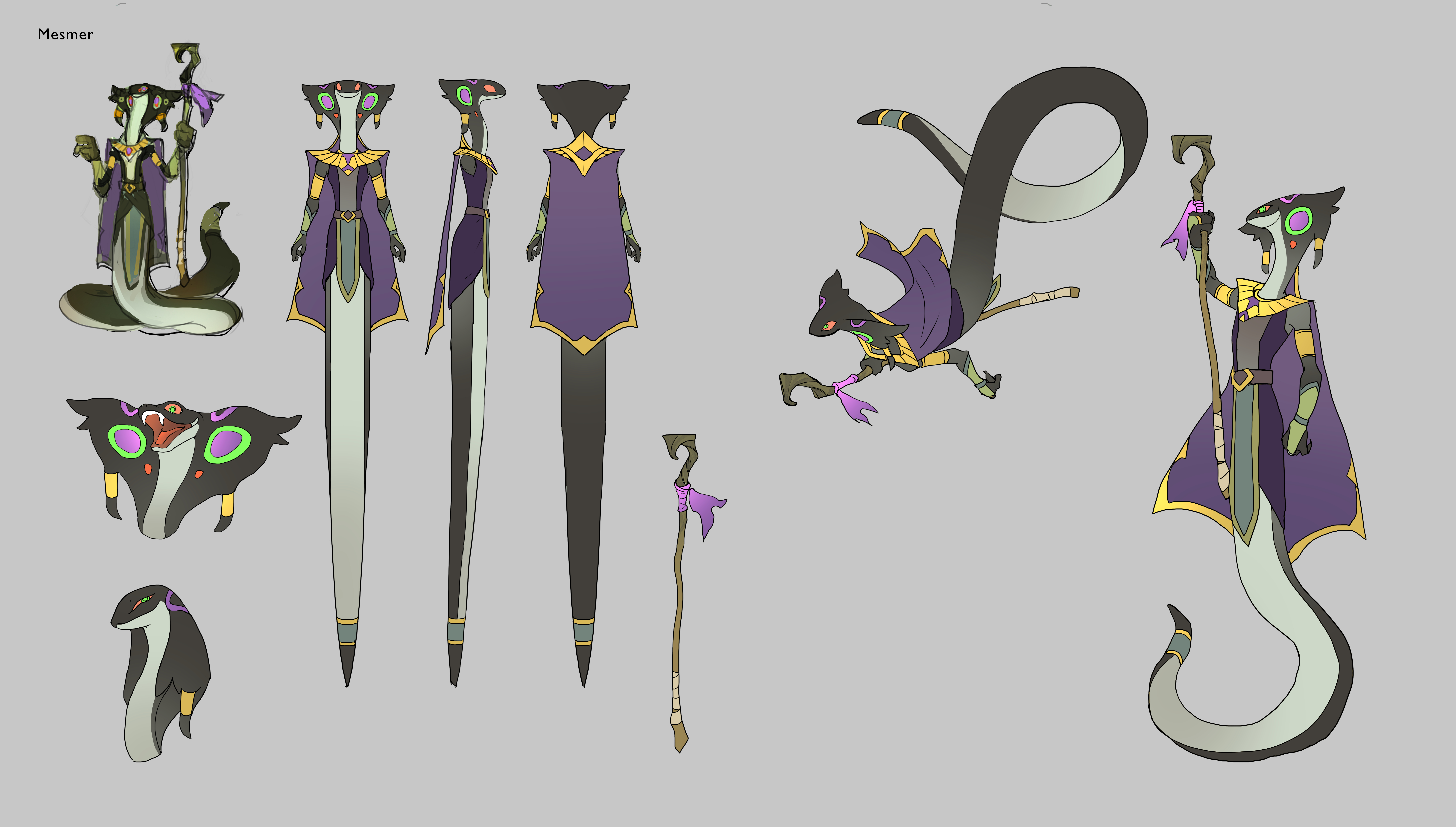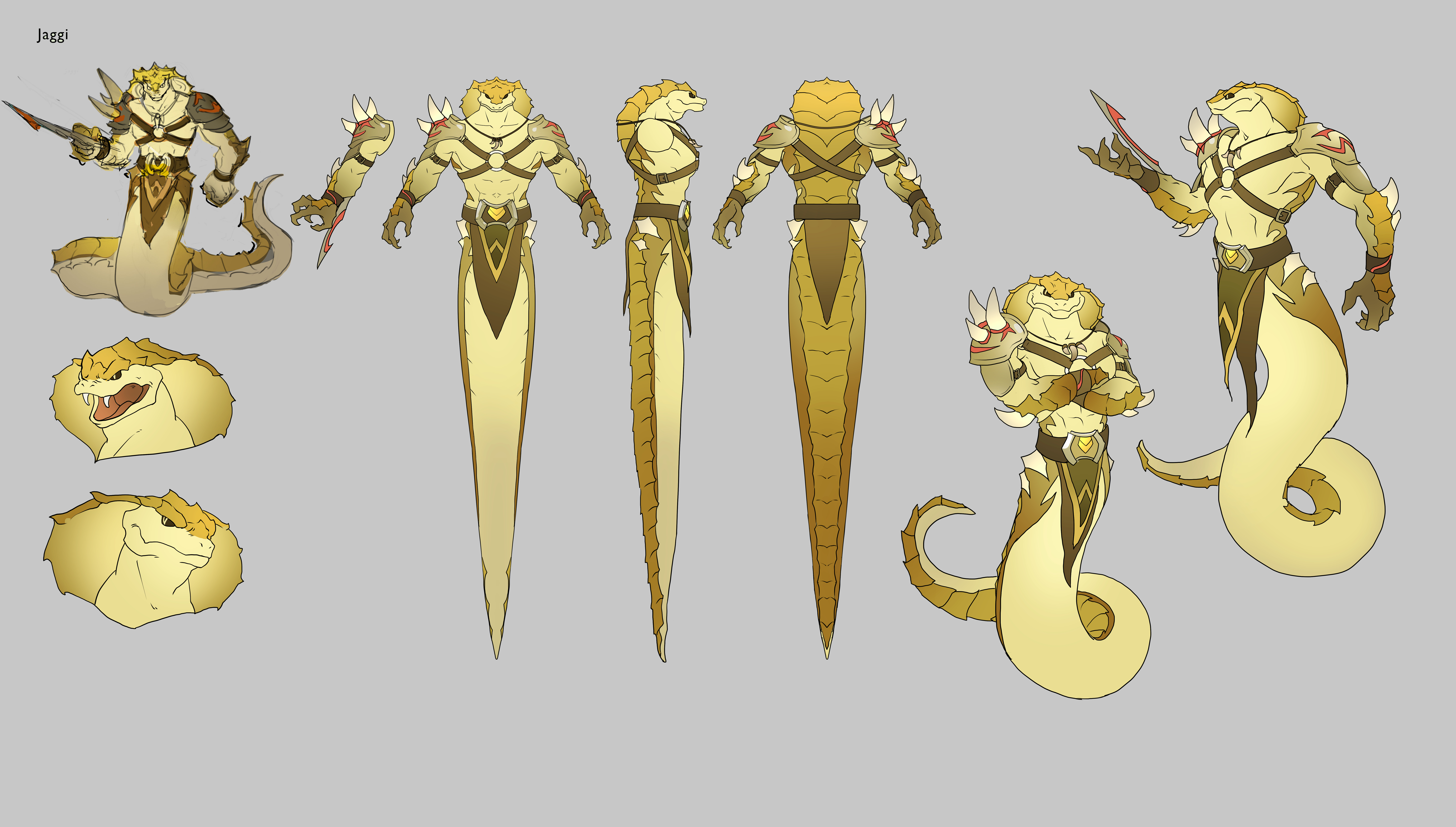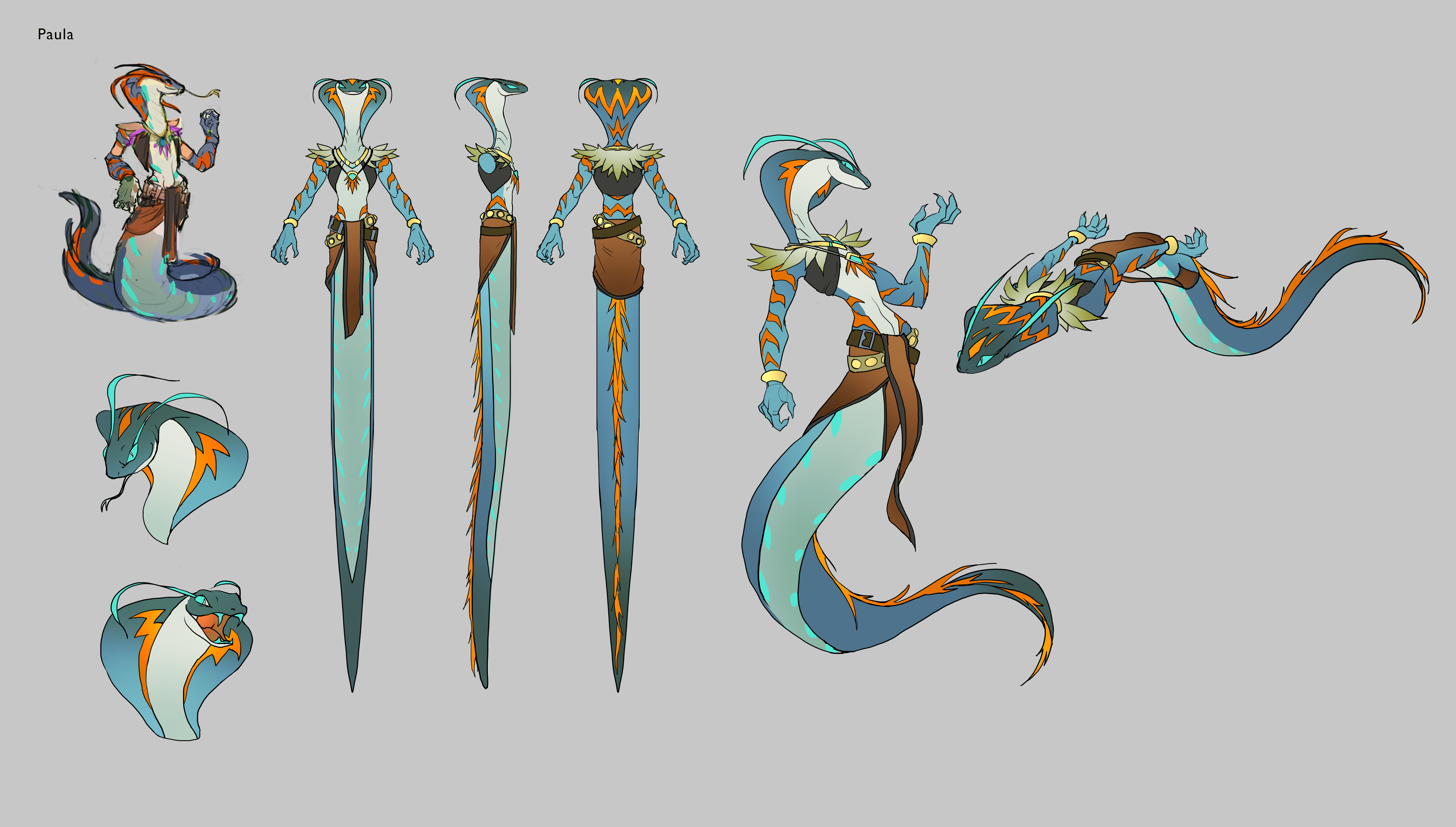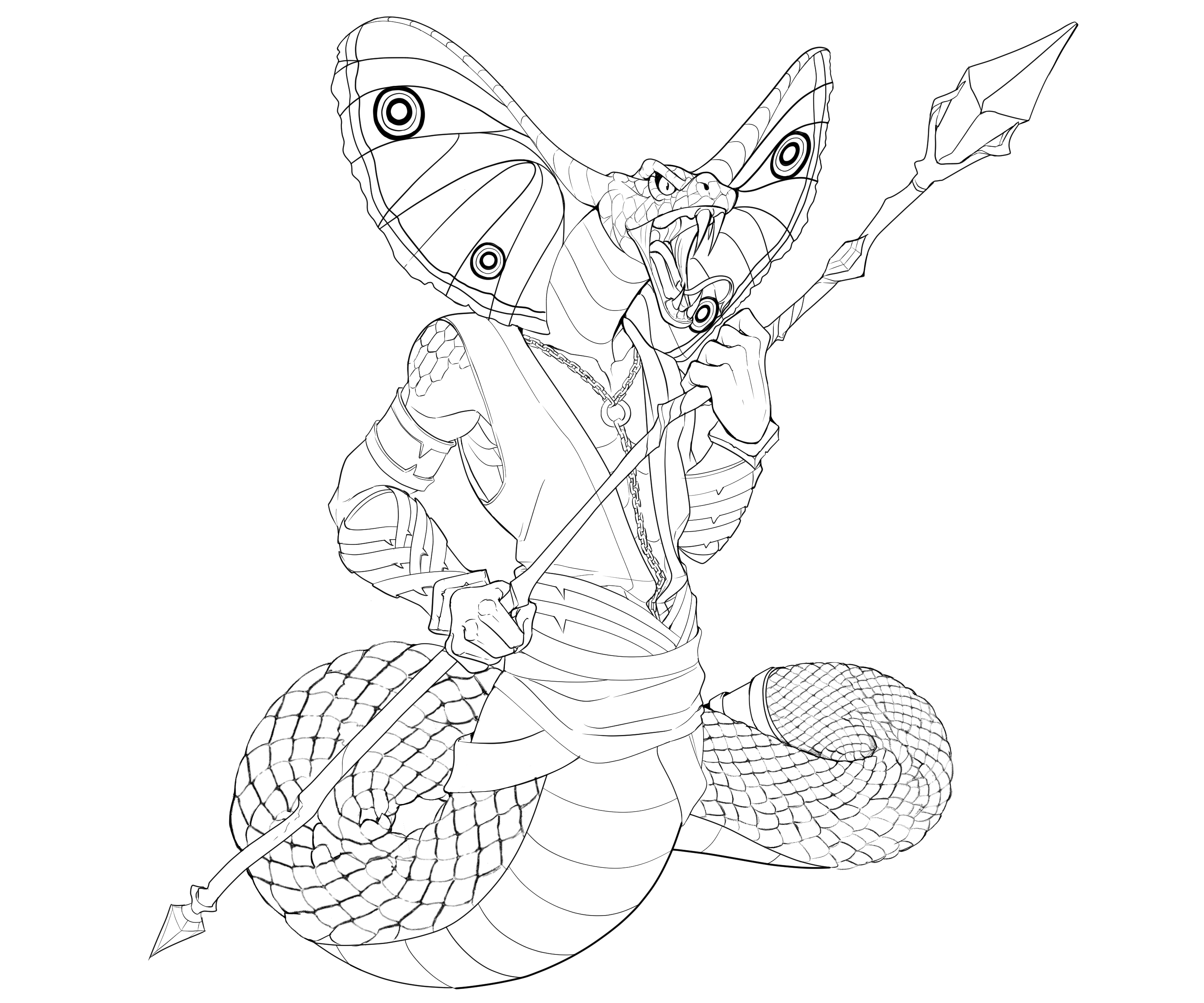Serpentfolk
Before the first humans laid their feet on this land, it was the time of those that slithered. Between the First Star fell and when the Temple of Shykkath laid to rest in a sea of burning sand, it was an age which few remember, but whose legacy remains strong in places abandonned by the hand of civilisation. Let me tell you about the Age of the Antediluvians sons of the Serpent.
Basic Information
Anatomy
The anatomy varies from the subtypes of serpentfolks
- The (XXXX), the most attuned to their snake form, have a tail, a pair of arms, and a regular snake head. Close to no human-ish reference to their body seems visible
- The (XXXX), have a , generally human, main body with a snake head, the two blending around the clavicles and sternum.
- The (XXXX) never have a regular anatomy as their are failed breeding experiments, which are animated as soulless husks for defending key locations their owners have.
Biological Traits
While some core anatomy makes for some subspecies, most sub-types of serpent can have variant serpent ancestry.
The mesmer are those with cobra ancestry, and also have unique mutations that helps me manipulate other humanoids.
The jaggi are related to hair bush spider. they skin have numerous pointy bits which makes them dangerous to contacts. They can also spring fangs out of their wrists.
The palua are related to cloaker pythons, a serpent that sheds regularly. they are master of disguise, and can reduce skin damage or contact poison with an accelerated shedding.
The palua are related to cloaker pythons, a serpent that sheds regularly. they are master of disguise, and can reduce skin damage or contact poison with an accelerated shedding.
Genetics and Reproduction
Serpent, like their animal cousin, reproduce by laying eggs.
However, they are very fond to use transmutation rituals on various species they enslaved, in a process called Ophidimorphosis. This mutated greatly the genetics and body structure of the victim, and make them possible to breed. Breeding slaves kept that way are usually kept until the first offsrping comes. if the offspring is deemed an interesting specimen with unique quirks, the slaves are kept alive to produce more. if those are deemed weak or abominations, the slaves are slaughtered and offered as meat for pets or other creatures for subsistance.
It is rather common for serpentfolk to , at times, consume the unborn offspring in another dark ritual that is made to gain their children's quirk for themselves.
It is not taboo in their culture, but those partaking in such act are either watched closely as it is a very suspicious behaviour, used often by usurpers to evolve and get stronger. Thus, those that keep those children alive usually keep them as tools for politics and spreading influence that they could not do alone.
Growth Rate & Stages
Contrary to other species, the growth rate to a regular serpentfolk adult can become very fast as those developed ritual to also quicken the body growth to an adult by using growth pods. This is a way for them to have more reliable forces in a faster way and bother less with a long education of an offspring unfit to defend themselves yet. However, the mental growth remains the same, and such those desiring to have influential children to use for their personnal agenda still need time to educate them. However, some decide to not give them such knowledge and keep only as brawns for protection. Those are called (rank) in the serpentfolk society.
Ecology and Habitats
Serpentfolks, due to their cold blood, really prefer hot temperature, be it an arid desert or a tropical jungle. If they have interest in more cold locations, they usually send their subordinates to do the dirty work, as they are rather sensible to such temperature drops without magic.
Dietary Needs and Habits
Serpentfolk are omnivorous but prefer the consumption of meat greatly, even from other humanoids. Many of their cultural rituals and ways to power have a certain condition to cannibalism.
Additional Information
Perception and Sensory Capabilities
The serpentfolk have the usual five sense. Their hearing, while not external, is acute. And almost all subspecies have heat sensors you makes them even more harder to hide from.
Some subspecies have also different developed senses, such as (species), which regualarly like in arboreal regions.
Civilization and Culture
History
The fall and exile
in (time), a select cult of snakefolk, led by the mesmeri (subace) Hil'kuthon, attempted to trap one of their god in hope to gather enough divine energy to convert on their own body and reach a sense of godhood. However, this went terrible as their cursed the whole mausoleum, making it for a massive landslide and sandstorm that sunked their settlement trapped still alive in a tomb of sand. Despite the perpetrator's deaths, the deity also met a permanent death, which affected the deity's followers, forbidding them on affecting the arcane veil. This event spreaded like wildfire in most serpentfolk settlements. Now that a strong pillars was weakened, many other serpentfolk races tried to take advantage of their weakened state and went into open hostilities to gain turf. the turmoil and civil unrest went into many months, and many former alliances were broken, each trying to take a piece for themselves. This became an opportunity for the enslaved race to attempt a coup, as their captors started to kill each others. The other races started to slowly build a force of themselve and waited for the opportunity to overthrow their enemies, bloodied by their recent fights. The months and years of conflict finally made the serpentfolks close to extinction and exiled into the fringes of civilisation for most of the survivors. Now, the serpentfolks usually hides from large settlements unless they have the capacity to hide their identity, as the generations of stigma and regular hostility made them common enemies for most sapient species. But the snakefolk memory is vivid, and some are patient but eager enough to claim back their throne they think deserves.
Lifespan
120 years (all subtypes)
Average Height
(XXXX) : 6'4'' - 7'0'' while standing normally, tail on the ground
Average Weight
XXX: 250-420
Average Length
14'2''-16'6''
Related Organizations
Related Myths
Related Technologies







Comments